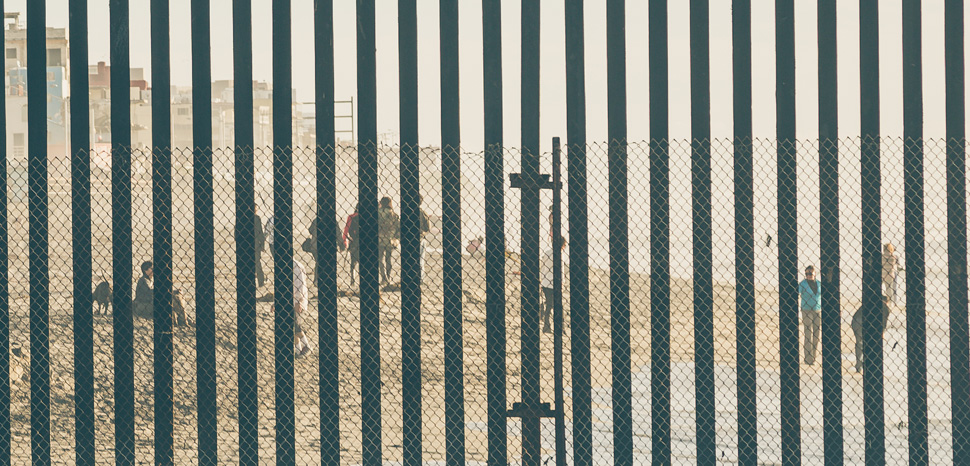There’s nothing inherently elegant or tasteful about a wall. Sure, Donald Trump can crow about his proposed “big beautiful wall” at the Mexican border, and then Democrats can fight back on the perceived villainous intent behind its creation but the reality remains: it’s not a fun sight to behold. A wall is a barrier that stretches across land it’s meant to protect and signifies a separation. A divide. A line that cannot be crossed. Depending on who you ask, it’s a testament to a broken or tattered relationship, or to the necessity for safeguards.
This isn’t Medicare, this isn’t taxes, this isn’t foreign policy. There are no realistic comparisons to Hitler to be summoned or any philosophical Yawm al-Qiyāmah awaiting rapture. It’s not fancy, it’s not fun – it’s just a wall.
Turn on the TV. I dare you to watch an hour of any major US capable news network and not hear one reference to the aforementioned structure. It dominates the media, and as a result, much of our national conversation. In fact, it seems the ‘wall’ is practically everywhere except where it’s supposed to be on the US- Mexico border. And that might be a reality the Trump administration has to face. The recent congressional budget deal purposefully left out any sort of monetary support for Trump’s wall, and only 25% of Republicans in congress support it at all.
But for the 3,095,313 residents of San Diego County California, it has been old news since the early 1990s. They have a wall; and strangely, nobody really talks about it.
The last stage of 20th century US politics was in no small way influenced by the debate over immigration policy. The national press was saturated with stories of illegal immigration (funny enough, Trump was involved in those back then too), and images flooded papers across the country showing immigrants overrunning freeways and disappearing into the metropolitan abyss of San Diego unmolested. At the time, almost half of all Mexican immigrants came through the region, using Tijuana as a starting point. The peak was in 1986, when border patrol agents nabbed 630,000 people trying to get across (For reference, that’s the entire population of Las Vegas)
It got so bad that signs on highways had to be erected to warn pedestrians of potential danger, and the surrounding roads became a deathtrap for runners heading north. Throughout the region, hundreds were struck by oncoming traffic during daring escapades, and hundreds of thousands were estimated to have traveled through the area illegally.
In 1989, San Diego began building a series of defense perimeters at specific high-crossing points in the region, which started by turning helicopter pads on their sides and welding them together to form barriers. But by 1996, the project had grown to become a full-scale border wall that separated the city from Tijuana, her Mexican counterpart across the border. Today it stretches across 46 of its 60-mile border, an intimidating object made up of fencing, barbed wire, and stone structures. And according to officials who worked there, it has done its job.
“It was an area that was out of control,” Border Patrol official Jim Henry said in an interview with NPR back in 2006. “There were over 100,000 aliens crossing through this area a year.” Henry went on to state that apprehensions decreased dramatically, down 95% in the years following the wall’s construction. Today, illegal immigration isn’t even close to what it was before security was tightened. Only 32,000 are caught on average yearly coming across, compared to 630,000 in 86’.
The wall’s success in eliminating local crossings and short-term immigration issues is encouraging, but, there’s more to the story on a statistical level. It’s important to remember these barriers are not a permanent blockage, but a temporary impediment designed to slow down a would-be crosser to the point of discouragement or at least apprehension. Any of the structures laid out on the border could be crossed without debilitating difficulty in a rural, less traveled area. At that point, it would simply be a matter of how long it would take to scale the wall, not if it could be scaled. As a recent Senate Appropriations overview saw it: “physical impedance and denial of access can be the most efficient and effective form of border security in high traffic areas with short vanishing times.”
The Arizona and Texas borders offer countless natural barriers that already perform that job without the help of the federal government, but still, immigrants cross over those areas despite the geographical obstacles. In relation to the greater argument surrounding border security in the United States, San Diego proves that highly dense, patrolled, populated areas can be effectively secured with the help of a wall. But if you skew that valuable example by throwing the wall across thousands of miles of rural desert in the middle of nowhere, you’ll find the results a lot less encouraging.
Yet even in the case of San Diego, the wall didn’t actually stop illegal immigration in general. Instead, illegal aliens coming through Tijuana simply shifted strategy and started going through Arizona and across the Rio Grande. In 2016, more than half of all illegal immigrants apprehended by border patrol were in Texas.
“There has been a massive effort and expense to create a border; this is unlike anything else,” said Professor Wayne Cornelius, a teacher at the University of California, San Diego, who was quoted in article from the New York Times back in September of 2017. “What it did more than anything is reroute the flows. It created a balloon effect to send people elsewhere and pay smugglers more to get them through.”
There’s also an economic impact. The San Diego Association of Governments (SANDAG) in 2006 found that the increased border restrictions had caused the area to lose 7.2 billion dollars over the years, and speculation remains that Tijuana’s drastic decline in the past decade might be due in part to those increased restrictions, which threatened to cripple the beneficial commercial relationship between the two cities.
For all the similarities that can be seen between today’s debate over immigration and that of the last four decades, the one thing that sticks out more than anything is that, well, it was much less of a debate. At least politically.
Both Democrats and Republicans strongly condemned the lack of border control and pushed for strengthening protections against illegal crossings. President Ronald Reagan, whose ideas would define Conservative politics for decades, granted amnesty to millions only a few years before, whilst simultaneously setting tougher border defenses.
This give-and-take approach, which put an emphasis on the human element without sacrificing common sense immigration restrictions, became a symbol of the bipartisan cooperation and sensible solutions that arose from the 1980s and 1990s.
This political method transcended not only parties, but administrations too. President Bill Clinton was also known for strong stances on immigration, and he wasn’t the only Democrat with a hankering for a tough border at the time. During the 1994 election, California’s Dianne Feinstein actually ran to the right of her Republican opponent in the senate race, claiming he wasn’t tough enough on illegal immigration. In a TV ad played over and over again on local news channels, Feinstein leveled death-blows against Orange County Conservatives who were nipping at her heels in the southern part of the state. “While Congressman Huffington voted against new border guards, Dianne Feinstein led the fight to stop illegal immigration” – this is how the attack ads would open, and shortly thereafter images of what can be assumed are illegal aliens crossing the border could be seen lurking in the background. She won the race.
Yet over the years, through countless changes in the political climate locally and nationally, the barrier has remained relatively unscathed both by efforts to remove it and by media punditry on the issue. It’s rare to see it discussed anywhere in the national media, save only a few academic research papers and the occasional NYT op-ed piece, usually written by some columnist looking to spice up his or her portfolio rather than actually trying to shed some light on the issue.
An inescapably bold geographical statement, the wall itself protrudes from the earth in a rather vile fashion, rooting up from its starting point and winding down the border in a haphazard style that could only reflect the politics involved in its construction. It tells a story of its own, and not in a metaphorical or figurative way. The Tijuana side of the fence is practically a canvas of hate, playing host to physical expressions of betrayal and resentment from the locals who see it as a symbol of American selfishness and perhaps also, a monument to institutional racially motivated bias.
The San Diego side, while still suffering from the occasional spray-paint blemish, is eerily simple. It’s quiet, bland, and lonely in some places. Its presence has been normalized for it offers no quality of an enticing nature that would draw attention. It’s not a threat, it’s not a challenge to the mundane sense of kinship you’ll find in the regional suburbs, it’s just there. And while it might be a controversial topic at city hall or maybe a few dinner tables in the predominantly Hispanic neighborhoods, for most, it’s a faded intricacy in a landscape dominated by normalized complications.
Over time, the unavoidable truth is that we seem to have lost a part of ourselves in the intrinsic hatefulness that has overwhelmed the debate on immigration. We speak of barriers with no doors, people with no humanity, and ideas with no introspection. Our consideration of the human experience extends only to ourselves, and we forget the countless lives that will be affected with whatever decision we come to.
Through the loud noises, flashing imagery, and biasedly spinned news stories we see unfolding like a Ragnarok on our national press day after day, an oddly clear picture can be surmised, for the only sane thesis that can be concluded from such chaos is the presence of said chaos. Two different worlds, made unique for their lack of humanizing qualities; two different sides of a critical debate unable to humanize each other for lack of effort.
It’s almost as if there’s a wall between them.
The opinions, beliefs, and viewpoints expressed by the authors are theirs alone and don’t reflect any official position of Geopoliticalmonitor.com.




